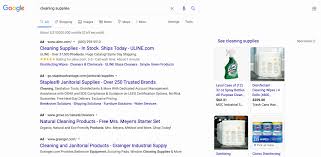The Power of PPC Advertising
Pay-Per-Click (PPC) advertising is a powerful digital marketing strategy that allows businesses to reach their target audience effectively. In PPC advertising, advertisers pay a fee each time their ad is clicked, providing a cost-effective way to drive traffic to websites and generate leads.
How Does PPC Advertising Work?
PPC ads are displayed on search engine results pages (such as Google) and other platforms where advertisers bid on keywords relevant to their target audience. When a user searches for a keyword that matches the advertiser’s bid, the ad is displayed prominently at the top of the search results.
The Benefits of PPC Advertising
- Immediate Results: Unlike organic search engine optimisation (SEO), PPC advertising delivers immediate results by placing your ads in front of potential customers right away.
- Targeted Reach: With PPC advertising, you can target specific demographics, locations, and interests to ensure your ads are seen by the right audience.
- Measurable ROI: PPC campaigns provide detailed analytics that allow you to track the performance of your ads in real-time. This data helps you make informed decisions to maximise your return on investment.
- Cost-Effective: With PPC advertising, you only pay when someone clicks on your ad, making it a cost-effective way to drive traffic and conversions for your business.
Key Strategies for Successful PPC Campaigns
To make the most of your PPC advertising efforts, consider implementing these key strategies:
- Keyword Research: Conduct thorough keyword research to identify relevant keywords that align with your business goals and target audience.
- Compelling Ad Copy: Create engaging ad copy that entices users to click on your ads and take action on your website.
- Landing Page Optimisation: Ensure that your landing pages are optimised for conversions and provide a seamless user experience for visitors who click on your ads.
- A/B Testing: Test different ad variations, keywords, and landing pages to identify what resonates best with your audience and improves campaign performance.
In conclusion, PPC advertising offers businesses a valuable opportunity to increase brand visibility, drive targeted traffic, and achieve measurable results in the competitive digital landscape. By implementing effective strategies and monitoring performance closely, businesses can harness the power of PPC advertising to grow their online presence and reach their marketing goals.
Essential FAQs About PPC Advertising: Understanding Costs, Benefits, and Best Practices
- What is PPC advertising and how does it work?
- What are the benefits of using PPC advertising for my business?
- How much does PPC advertising cost?
- How can I measure the success of my PPC campaigns?
- What platforms can I use for running PPC ads?
- Do I need a specialist to manage my PPC campaigns?
- How do I choose the right keywords for my PPC ads?
- What are some common mistakes to avoid when running PPC campaigns?
What is PPC advertising and how does it work?
PPC advertising, short for Pay-Per-Click advertising, is a digital marketing strategy where advertisers pay a fee each time their ad is clicked. It is a cost-effective way for businesses to drive targeted traffic to their websites and generate leads. In PPC advertising, advertisers bid on keywords relevant to their target audience, and when a user searches for those keywords, the ad is displayed prominently at the top of search engine results pages. This immediate visibility allows businesses to reach potential customers at the right moment and track the performance of their ads in real-time through detailed analytics. By leveraging PPC advertising effectively, businesses can increase brand exposure, drive conversions, and achieve measurable ROI in the competitive online landscape.
What are the benefits of using PPC advertising for my business?
Utilising PPC advertising for your business offers a multitude of benefits that can significantly impact your online presence and marketing efforts. One key advantage is the immediate results it provides, allowing your ads to reach potential customers swiftly. Additionally, PPC advertising enables targeted reach, ensuring that your ads are displayed to specific demographics, locations, and interests relevant to your business. Moreover, the measurable ROI and cost-effectiveness of PPC campaigns empower businesses to track performance in real-time and optimise their strategies for maximum return on investment. Overall, leveraging PPC advertising can enhance brand visibility, drive traffic, and ultimately boost conversions for your business in the competitive digital landscape.
How much does PPC advertising cost?
The cost of PPC advertising can vary depending on several factors, including the competitiveness of your industry, the keywords you target, and your campaign objectives. With PPC advertising, you have control over your budget by setting daily or monthly limits on how much you are willing to spend. Additionally, you only pay when someone clicks on your ad, making it a cost-effective way to reach your target audience and drive traffic to your website. It’s important to consider the potential return on investment (ROI) that PPC advertising can provide in terms of generating leads, increasing sales, and boosting brand visibility. By carefully planning and monitoring your PPC campaigns, you can maximise the value of your advertising budget and achieve meaningful results for your business.
How can I measure the success of my PPC campaigns?
Measuring the success of your PPC campaigns is essential for evaluating their effectiveness and making informed decisions to optimise performance. Key metrics to consider include click-through rate (CTR), conversion rate, cost per acquisition (CPA), return on ad spend (ROAS), and overall return on investment (ROI). By tracking these metrics and analysing campaign data, you can gain valuable insights into what is working well and where improvements can be made. Additionally, using tools like Google Analytics and conversion tracking can provide detailed performance data to help you assess the impact of your PPC efforts accurately. Regular monitoring and analysis of these metrics will allow you to refine your strategies, allocate budgets effectively, and ultimately maximise the success of your PPC campaigns.
What platforms can I use for running PPC ads?
When it comes to running PPC ads, there are several platforms available for advertisers to choose from. Some of the most popular platforms for PPC advertising include Google Ads, which allows you to display ads on Google search results and partner websites; Microsoft Advertising (formerly Bing Ads), which targets users on the Bing search engine; social media platforms like Facebook Ads and Instagram Ads, offering highly targeted ad placements based on user demographics and interests; and other networks such as LinkedIn Ads for B2B targeting, Twitter Ads for real-time engagement, and Amazon Advertising for product-focused campaigns. Each platform has its unique features and audience reach, allowing advertisers to tailor their PPC campaigns to best suit their marketing objectives and target audience.
Do I need a specialist to manage my PPC campaigns?
When it comes to PPC advertising, the question of whether you need a specialist to manage your campaigns is a common one. While it is possible to set up and run PPC campaigns on your own, working with a specialist can offer significant benefits. A PPC specialist brings expertise in keyword research, ad copywriting, campaign optimisation, and performance tracking that can help maximise the effectiveness of your campaigns. Their knowledge of industry best practices and experience in managing PPC accounts can lead to improved results, higher ROI, and a more strategic approach to reaching your target audience. Ultimately, partnering with a PPC specialist can save you time and resources while delivering better outcomes for your advertising efforts.
How do I choose the right keywords for my PPC ads?
Choosing the right keywords for your PPC ads is crucial for the success of your campaign. Start by conducting thorough keyword research to identify relevant terms that align with your business objectives and target audience. Consider using keyword research tools to discover high-performing keywords with moderate competition. It’s essential to select keywords that are specific, relevant, and likely to attract users who are interested in your products or services. Additionally, focus on long-tail keywords that reflect user intent and have a higher chance of converting into leads or sales. Regularly monitor and refine your keyword selection based on performance data to optimise your PPC ads for maximum impact and return on investment.
What are some common mistakes to avoid when running PPC campaigns?
When running PPC campaigns, it is crucial to avoid common mistakes that can hinder the effectiveness of your advertising efforts. Some key errors to steer clear of include neglecting keyword research, setting overly broad targeting parameters, failing to track and analyse campaign performance, ignoring ad relevance and quality score factors, and not optimising landing pages for conversions. By addressing these pitfalls and implementing best practices in your PPC campaigns, you can maximise your return on investment and achieve success in reaching your target audience with compelling ads that drive meaningful results.


